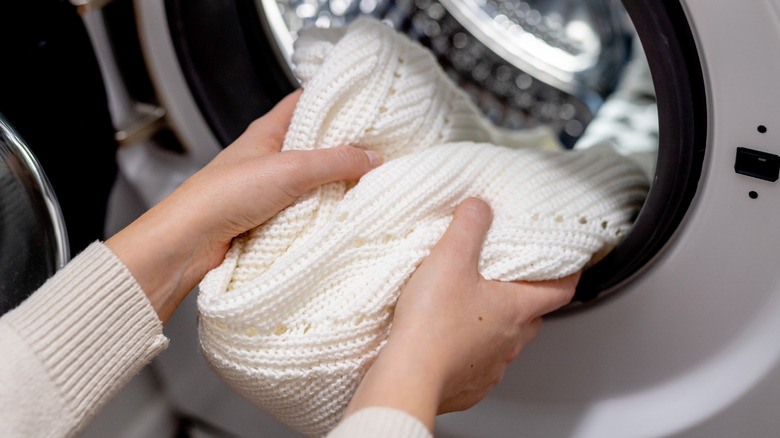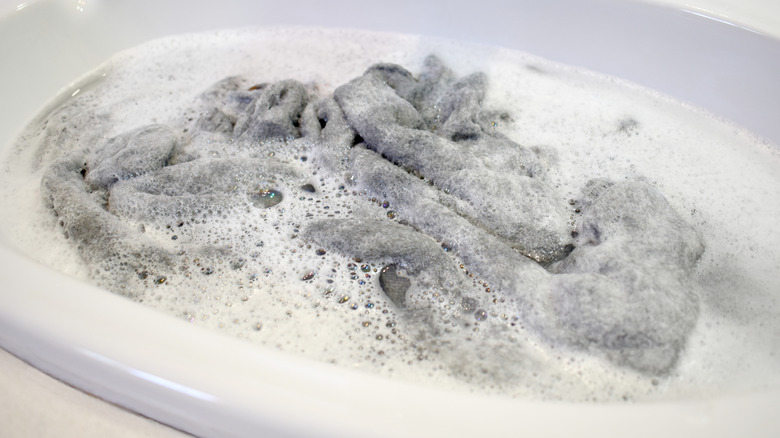The Difference Between Shrunken And Felted Laundry (And What To Do)
Once you've experienced the pain of taking a beloved garment out of the washing machine only to discover that it's now two-thirds its original size, you never forget it. But believe it or not, there's an even worse possibility, and it's called felting. While shrunken laundry has only changed size, felted laundry has also changed texture, and it's much more difficult (usually impossible) to undo.
Wool sweaters are especially infamous for shrinking, but several other fabrics are likely to shrink in the laundry, too, including linen, cotton, silk, bamboo, and rayon. Heat, moisture, and high agitation all work together to cause the fibers in these fabrics to contract. But there are different levels of shrinkage, from the slight to the drastic. The more heat, moisture, and agitation, the more a garment will shrink.
Felting is a specific level of shrinkage in which the fibers have contracted so much that they get bound together. It creates a dense texture that looks like, well, felt. Sometimes, the process is done intentionally for the fuzzy look, but it can also happen accidentally in the laundry. Wool is most likely to felt because of its coarse scales, followed by other scaly animal fibers like alpaca and cashmere. Smoother fibers like cotton or linen are unlikely to felt. You can unshrink your clothes, but felting is often permanent. Luckily, the process for preventing shrinking or felting is pretty much the same.
How to unshrink, and when felting can't be fixed
The more shrinkage that has occurred, the harder it is to restore a garment to its original size. For garments that have only lost 1 to 2 inches, you can use a steamer across the garment while stretching it out. If more stretching is needed, soak the item for 10 minutes in lukewarm water with baby shampoo, wool detergent, hair conditioner, or fabric conditioner (⅓ cup per gallon of water). This loosens the fibers from each other. Rinse, press the excess water out with a towel, and lay the item flat. Stretch it into the old size and shape and wait for it to dry. You can also use a blocking mat, which is designed to shape knit and crochet garments; gradually stretch it further every 30 minutes.
Felted garments are another matter. Felting can shrink a garment by up to 30%, and it's often impossible to un-do. However, if the garment has only been slightly felted — it looks fuzzy, but you can still see the individual stitches — you may be able to stretch it, if not all the way, at least to the point where it's wearable. The texture will likely still look different. The process is similar to the above: soak the garment in water and hair or fabric conditioner, roll it dry in a towel, then gently stretch it out on a blocking mat and leave it until it's dry. If you don't have a blocking mat, you can also try a foam board, a piece of wood, or any other surface you can securely pin the garment to while it dries.
How to prevent shrinking or felting
The cardinal rule for preventing shrinkage, felting, or any other laundry mishaps, for that matter, is to follow the care instructions on the label. But if you're missing that label, you can still take precautions to keep your laundry safe. Since heat, moisture, and agitation cause fabrics to shrink, minimize all three during the laundering process.
Use cool water to wash fabrics that you don't want to shrink — hot water opens up the fibers and allows them to swell and contract. For certain fabrics, you may want to use a specialty detergent, such as laundry detergent for cashmere and wool. Regular detergent can damage wool and make it more vulnerable to shrinkage. To minimize agitation, hand wash in a sink or basin or use the hand wash setting on your washing machine, putting the shrinkable garments in a delicates bag. Gently blot excess water out with a towel rather than wringing it out.
Avoid the dryer at all costs, as a high level of friction is a primary cause of felting. Also, avoid drying sweaters on clothes hangers since they may lose their shape or get bumps on the shoulders. Instead, air dry flat on a towel, reshaping as needed before leaving it. Dry cleaning is also an option if you prefer ease over affordability.

